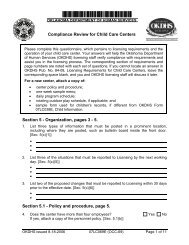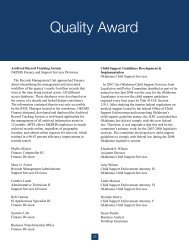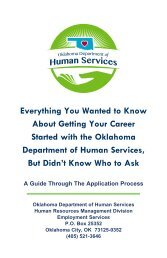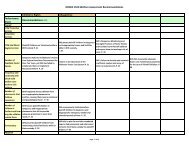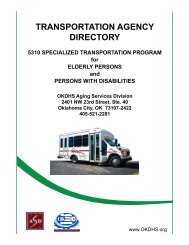The Oklahoma Pinnacle Plan - Oklahoma Department of Human ...
The Oklahoma Pinnacle Plan - Oklahoma Department of Human ...
The Oklahoma Pinnacle Plan - Oklahoma Department of Human ...
Create successful ePaper yourself
Turn your PDF publications into a flip-book with our unique Google optimized e-Paper software.
<strong>The</strong> <strong>Oklahoma</strong> <strong>Pinnacle</strong> <strong>Plan</strong>:<br />
An Improvement <strong>Plan</strong> for Child Welfare Services<br />
March 2012<br />
20.8 percent for all CWS in the calendar year 2011. Turnover and its attendant challenges have<br />
significant fiscal impact and can hurt children and families.<br />
WHAT PERFORMANCE AREAS WILL THIS IMPACT?<br />
Implementing improvements in the area <strong>of</strong> the child welfare workforce will undoubtedly<br />
impact all 15 performance areas; however, the real focus is caseload and workload size.<br />
THE WORKLOAD AND CASELOAD HISTORY<br />
Caseloads have fluctuated throughout the past five years, but have significantly reduced<br />
overall. OKDHS has been successful in safely reducing the number <strong>of</strong> children in care, thereby<br />
driving down the average number <strong>of</strong> children in a caseload. Turnover has improved at times,<br />
but over the past year, it has been at a critical level; many individuals have described it as a<br />
crisis. Turnover and vacancy rates impact workload. <strong>The</strong> amount <strong>of</strong> time required to post a<br />
vacant position, hire a qualified individual and train a new CWS causes remaining staff to be<br />
burdened with higher caseloads and unreasonable work demands. Currently, there are<br />
approximately 1,100 CWS in the state. At the end <strong>of</strong> SFY2012, the training unit will have<br />
trained over 500 new CWS, demonstrating a startling and concerning picture <strong>of</strong> the workforce<br />
and staff tenure. CWS leaving the agency, who agreed to respond to a survey, described their<br />
supervisors as supportive and the work as rewarding, but described unreasonable work<br />
demands, low pay, low morale, and a negative image <strong>of</strong> the agency as reasons for leaving.<br />
Most report they would consider returning to OKDHS if these working conditions changed.<br />
OKDHS conducted a workload study in 1998, but with the changes brought about by revisions<br />
to federal and state statutes and the implementation <strong>of</strong> the practice model, there is not clear<br />
agreement on what constitutes a fair workload. <strong>The</strong> agency has also struggled with the<br />
concept <strong>of</strong> primary and secondary assignments and the role <strong>of</strong> each CWS within the case.<br />
THE REAL PROBLEMS – HIGH TURNOVER AND DIFFICULTY DEFINING REASONABLE<br />
WORKLOAD<br />
A sound practice model, research-informed assessment tools, services and<br />
interventions, well-written policy, and committed leadership are critical but not<br />
sufficient.<br />
Absolutely nothing will substitute for well-qualified, stable, and well-supported<br />
front-line staff — CWS and supervisors — with reasonable workloads.<br />
15







